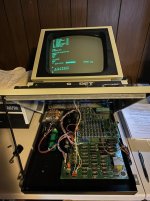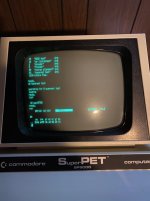The first thing to say is that a 4116 is a 16Kbit * 1 bit device - not a 2K[byte] device. This means that eight ( 8 ) 4116 devices are required to form a byte.
I have worked on the single-board SP9000 - so I am somewhat rusty on the 3-board setup. But, if memory serves me correctly, the following is likely to apply:
Banks 0 and 1 = U29-U36.
Banks 2 and 3 = U37-U44.
Banks 4 and 5 = U45-U52.
Banks 6 and 7 = U53-U60.
The lower-numbered device of each block of 8 chips (i.e. U29, U37, U45 and U53) being the most significant data bit (DB7) with the higher-numbered device being the least significant data bit (DB0) (i.e. U36, U44, U52 and U60).
One of the 8 banks is mapped into the address space $9xxx depending upon the setting of the bank switch register (the least significant 3 bits).
You also have to remember that testing RAM when it is set to READ-ONLY doesn't work - and neither will it work if the switch is set to PROG and the bank switch register set to WRITE-PROTECT either.
I would first check all of the power supply rails to make sure they are within specification (+/- 5% of rated voltage at most). So (for the +5V rail) that should be 4.75V to 5.25V. If you have an oscilloscope - check for ripple and high frequency noise.
Are your 4116 DRAMs in sockets? If so, I wouldn't bother about piggy-backing. Just buy eight spare devices from a reputable supplier and swap an entire block of 8 devices over. If those two banks now work - you can selectively replace (say) DB0 from that block with an unknown device and see if that returns as FAULTY or not. Divide an conquer.
Can you point me to a copy of the test program you are using?
The other thing of note is the horrible 'analogue' logic around U26 - and C76. Timing circuits are notorious for drifting with age and (because this is the refresh and /RAS signal generation) could cause memory access problems.
You might also want to consider a little 4116 DRAM tester that you can buy? 4116 DRAM is notoriously unreliable. Piggy-backing (in my opinion) is generally inconclusive - but I have known it to work once or twice and is a preferential test before desoldering and replacing a device... If it is in a socket though, I wouldn't bother. However, whatever you do, make sure it is methodical and you keep notes. There is nothing worse than trying to find a pattern and then forgetting where the devices are that you first started with! If you start swapping devices around, at least put a sticker on each device to start with stating which 'U' device it is!
You also haven't stated what problems you are actually observing...
Dave



